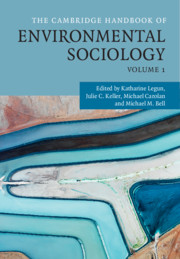Book contents
- The Cambridge Handbook of Environmental Sociology Volume 1
- The Cambridge Handbook of Environmental Sociology
- Copyright page
- Contents
- Figures
- Tables
- Contributors
- Foreword
- Introduction
- Part I Theory in Environmental Sociology
- Part II The Economy and Environmental Sociology
- Part III Culture and Environmental Sociology
- 12 Media and the Environmental Movement in a Digital Age
- 13 National Parks and (Neo)Colonialisms
- 14 Post Carbon Transition Futuring: For a Reconstructive Turn in the Environmental Social Sciences?
- 15 Outer Space and New Frontiers to Environmental Imaginations
- 16 New Territory for Environmental Sociology: Environmental Philosophy and Nature-Based Tourism
- Part IV Politics, Power, State
- Part V Social Justice
- Index
- References
15 - Outer Space and New Frontiers to Environmental Imaginations
from Part III - Culture and Environmental Sociology
Published online by Cambridge University Press: 05 November 2020
- The Cambridge Handbook of Environmental Sociology Volume 1
- The Cambridge Handbook of Environmental Sociology
- Copyright page
- Contents
- Figures
- Tables
- Contributors
- Foreword
- Introduction
- Part I Theory in Environmental Sociology
- Part II The Economy and Environmental Sociology
- Part III Culture and Environmental Sociology
- 12 Media and the Environmental Movement in a Digital Age
- 13 National Parks and (Neo)Colonialisms
- 14 Post Carbon Transition Futuring: For a Reconstructive Turn in the Environmental Social Sciences?
- 15 Outer Space and New Frontiers to Environmental Imaginations
- 16 New Territory for Environmental Sociology: Environmental Philosophy and Nature-Based Tourism
- Part IV Politics, Power, State
- Part V Social Justice
- Index
- References
Summary
This chapter explores the importance and usefulness of considering outer space as an environment from the perspective of environmental sociology. It identifies that, whilst 'outer space' may imply a space outside of the human environment, global society is increasingly dependent on space technology. Although our notions of 'the environment' are often limited to terrestrial natures, this chapter follows other recent arguments in advocating a closer examination of how different 'environments' are being produced in outer space. The chapter focusses on three different, though inter-related, ways in which the outer space environment is materially, discursively, and imaginately produced. First, it considers outer space as an 'abundant' environment, in which outer space is seen as an infinite supply of resources for economic expansion. Second, it considers outer space as a 'risk' environment crowded with debris that threatens the sustainability of Earth's orbit in particular. Third, it considers outer space as a 'wilderness' environment to be valued either because of its intrinsic worth or because of the role it can play in addressing human destructiveness. The chapter concludes by expressing hope that the lessons learnt from terrestrial environmental sociology can improve our relationship with the space environment in pivotal times.
Information
- Type
- Chapter
- Information
- The Cambridge Handbook of Environmental Sociology , pp. 243 - 261Publisher: Cambridge University PressPrint publication year: 2020
References
Accessibility standard: Unknown
Why this information is here
This section outlines the accessibility features of this content - including support for screen readers, full keyboard navigation and high-contrast display options. This may not be relevant for you.Accessibility Information
- 1
- Cited by
